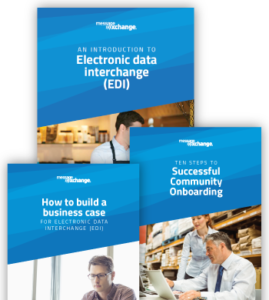You might also like…
The benefits of EDI: an infographic
Newsletter
Sign up to get the latest EDI updates
Stay up-to-date with industry news, useful blogs and whitepapers, expert tips and more.
EDI for suppliers: What option is best for my business?
What is EDI?
EDI is the electronic exchange of business information, like purchase orders and invoices. This information goes straight in and out of the retailer’s software. It’s of benefit to the retailer because it’s more efficient than paper or PDFs, it gives them real-time visibility of their purchases and products, and it reduces costs. You can find out more about EDI in this whitepaper. For suppliers, it’s important to be aware of your options when it comes to EDI and to choose the best option for your business.What are my options?
EDI webforms
The simplest solution for compliance is EDI webforms. This allows you to logon to a web portal to view purchase orders and respond by sending back the required information such as purchase order responses, advance shipping notices and invoices. The information input into the web portal is sent directly to your customers’ software. EDI webforms has a number of benefits:- No establishment costs
- It’s easy to set up
- It has an easy-to-use interface
- You can trade with many retailers from the one portal
- It’s accessible anywhere with internet
- It’s cost effective.
- No support cost.
EDI gateway
A more automated option is an EDI gateway. The fully integrated solution exchanges information with your customers directly to and from your ERP or accounting software. This option has the least impact on your current process and requires minimal manual processing because it takes the data from your software to send EDI documents to your customers. To gain even more benefits from your EDI gateway, it can be used to update other systems in your business. For example, when an order is despatched to one of your customers, it can automatically update inventory levels in your warehouse management system. This information can even be sent via EDI to your partners to keep them up-to-date with your inventory levels. Some of the benefits of using an integrated solution include:- using your existing software
- no need for data re-entry
- automating your manual processes
- improving data accuracy
- faster order processing.
Which option is right for my business?
It is important to choose an option that:- sets your business up for future adaptability
- reduces the costs imposed on your business provides the most value.
- The amount of orders you receive, the number of products you sell and the amount of information that is required from your customers As these factors increase, so does the amount of manual inputting you will be required to input into each form
- The functionality of the software you currently use in your business For example, if you retailers require an advanced shipping notice with SSCC labels. Can your software produce these?
- Your strategic goals For example, if you want to integrate with other systems or automate other business processes.
Consider EDI webforms if…
[vc_column_inner width="1/2" css=".vc_custom_1565315132956{padding-top: 0px !important;padding-bottom: 0px !important;background-color: #1b75bb !important;}"]Consider an EDI gateway if…
[vc_column_inner width="1/2" css=".vc_custom_1565317604253{padding-top: 0px !important;background-color: #eeeeee !important;}"]You trade with a small number of retailers
[vc_column_inner width="1/2" css=".vc_custom_1565317619229{padding-top: 0px !important;padding-bottom: 0px !important;background-color: #eeeeee !important;}"]You trade with a large number of retailers
[vc_column_inner width="1/2" css=".vc_custom_1565317604253{padding-top: 0px !important;background-color: #eeeeee !important;}"]You receive roughly 30 or less orders a week
[vc_column_inner width="1/2" css=".vc_custom_1565317619229{padding-top: 0px !important;padding-bottom: 0px !important;background-color: #eeeeee !important;}"]You receive more than roughly 30 orders a week
[vc_column_inner width="1/2" css=".vc_custom_1565317604253{padding-top: 0px !important;background-color: #eeeeee !important;}"]You sell a limited range of products
[vc_column_inner width="1/2" css=".vc_custom_1565317619229{padding-top: 0px !important;padding-bottom: 0px !important;background-color: #eeeeee !important;}"]You sell a large range of products
[vc_column_inner width="1/2" css=".vc_custom_1565317604253{padding-top: 0px !important;background-color: #eeeeee !important;}"]Your customers don’t require too much data
[vc_column_inner width="1/2" css=".vc_custom_1565317619229{padding-top: 0px !important;padding-bottom: 0px !important;background-color: #eeeeee !important;}"]Your customers require a substantial amount of information
[vc_column_inner width="1/2" css=".vc_custom_1565317604253{padding-top: 0px !important;background-color: #eeeeee !important;}"]Your software can’t generate the information required by your customers
[vc_column_inner width="1/2" css=".vc_custom_1565317619229{padding-top: 0px !important;padding-bottom: 0px !important;background-color: #eeeeee !important;}"]You want automated processes
[vc_column_inner width="1/2" css=".vc_custom_1565317604253{padding-top: 0px !important;background-color: #eeeeee !important;}"]You’re just starting out with EDI
[vc_column_inner width="1/2" css=".vc_custom_1565317619229{padding-top: 0px !important;padding-bottom: 0px !important;background-color: #eeeeee !important;}"]You don’t want to double-enter data
[vc_column_inner width="1/2" css=".vc_custom_1565317604253{padding-top: 0px !important;background-color: #eeeeee !important;}"][vc_column_inner width="1/2" css=".vc_custom_1565317619229{padding-top: 0px !important;padding-bottom: 0px !important;background-color: #eeeeee !important;}"]You need a flexible solution that grows as your business does
Interested in implementing EDI for your business? Get a free consultation from one of our EDI experts.EDI more than just automating your supply chain
- Gain better visibility into the supply chain
- Reduce errors in exchanging paper or PDF documents
- Reduce costs
- Increase information security.
Gain better visibility into the supply chain
With a manual purchase order and invoice, can a buyer answer questions like:- Can the supplier fulfil my order?
- When will the goods be shipped?
- When can I expect my goods to arrive?
- What is in each package I am about to receive?
Reduce errors in exchanging paper or PDF documents
Traditional procurement has many manual processes that are prone to error. Human mistakes occur for a number reasons including:- Inputting incorrect numbers or values
- Missing or skipping key steps in the process
- Transferring the wrong purchase order information
 |
|||||
| Buyer manually enters the purchase order in their software | Buyer sends order to supplier via email | Supplier manually enters the purchase order in their software | Supplier manually enters the invoice in their software | Supplier sends invoice to buyer via email | Buyer manually enters the invoice in their software |
 |
|||||
| Buyer enters the purchase order in their software | Purchase order appears in Supplier’s software | Supplier enters the invoice in their software | Invoice appears in Buyer’s software | ||
Reduce costs
In low-margin businesses, reducing costs is critical. Think of a company that issues thousands of purchase orders a month. They’ll likely receive at least one invoice for every purchase order issued. Without EDI, that’s a lot of manual handling. Some organisations have put a price on manually processing a single invoice in the ballpark of $30. You can see how it adds up! EDI vastly simplifies the supply chain process through automation. Some examples of costs reductions are:- Manual data entry costs: EDI automates many manual data entry processes, reducing the amount of labour required.
- Transaction costs: No physical sending of documents to your partners reduces costs related to printing, postage and filing.
- Receiving and shipping related costs: By receiving shipment information from suppliers prior to delivery, you can prepare in advance for receiving goods. By streamlining the receiving process, you can achieve reductions in labour costs.
- Error correction costs: Errors in the supply chain can result in extra costs being incurred. With the elimination of manual steps in your processes, errors are reduced. If errors do occur, they can be found and corrected much faster.
Increase information security
In today’s business environment, information security is a prominent issue. Sending sensitive information through unsecure channels can add risk to your business. You could be sending these via email, post or even SMS, which can easily be sent to the wrong person or even intercepted. EDI can send this information more securely than conventional methods. Using secure message communication types such as Secure File Transfer Protocol (sFTP) or AS2 decreases your risk. EDI adds a layer of authentication to the process which is required for the information to be sent. It also limits the connection to specific partners reducing the risk of your sensitive business information being sent to the wrong recipient.Newsletter
Sign up to get the latest EDI updates
Stay up-to-date with industry news, useful blogs and whitepapers, expert tips and more.

Looking for more information?
Get in-depth information and how-tos in our whitepapers. Find out how to build a business case, learn how to onboard your network and more.
Contact Us
Looking for a solution for your business? Contact us and we’ll get in touch with more info


